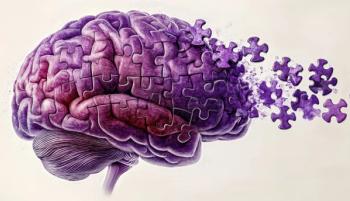
- Psychiatric Times Vol 19 No 11
- Volume 19
- Issue 11
The Role of B Vitamins, Homocysteine in AD and Vascular Dementia
Alzheimer's disease (AD) is a devastating and debilitating neurodegenerative condition, and the most common cause of dementia among the elderly. Despite considerable advances in the cellular and molecular biology of AD, however, little progress has been made in identifying the causes of the disease.
Alzheimer's disease (AD) is a devastating and debilitating neurodegenerative condition, and the most common cause of dementia among the elderly. Despite considerable advances in the cellular and molecular biology of AD, however, little progress has been made in identifying the causes of the disease. Both the canonical plaques and tangles correlate poorly with the extent of cognitive decline, and it is unclear whether they themselves are the primary culprits or rather markers of a later stage in a disease process (Joseph et al., 2001). If the latter is true, then concomitant pathologies such as cerebrovascular disease may be significant contributors to the disease even if they are neither necessary nor sufficient for plaque and tangle formation. Indeed, AD and cerebrovascular disease frequently overlap (de la Torre, 2002; Kalaria and Ballard, 1999; Moody et al., 1997), and the presence of such pathology contributes synergistically to the severity of cognitive impairment, beyond what would be predicted on the basis of the AD pathology alone (Nagy et al., 1997). In this context, recent epidemiological evidence for an association of AD with elevated serum total homocysteine (tHcy) and low levels of B vitamins is of considerable interest (Clarke et al., 1998; Seshadri et al., 2002; Snowdon et al., 2000).
Elevated tHcy is a recognized risk factor for vascular disease (Boushey et al., 1995; Clarke et al., 1991), cerebrovascular disease (Brattstrom et al., 1984; Yoo et al., 1998), stroke (Bostom et al., 1999a) and all-cause morbidity (Bostom et al., 1999b). Homocysteine is a non-protein-forming, sulfur-containing amino acid, produced by the body as it metabolizes the essential amino acid methionine. Homocysteine is metabolized by two pathways: methylation, in which methionine is synthesized using folate and vitamins B12, B6 and B2, and transsulfuration, in which vitamin B6 is a cofactor in the degradation of homocysteine (see Figure, as well as Selhub [1999] or Finkelstein [1990] for review).
Homocysteine metabolism is regulated by the cell to maintain a balance between the methylation and transsulfuration pathways and to maintain low levels of this potentially cytotoxic amino acid (Brattstrom et al., 1994; Brattstrom et al., 1988; Finkelstein, 1990). Barring kidney malfunction, the occurrence of hyperhomocysteinemia indicates that homocysteine metabolism has been disrupted and that the export mechanism is disposing excess cellular homocysteine into the blood. This response prevents toxicity to the cell, but leaves vascular tissue exposed to the potentially harmful effects of excess homocysteine.
Hyperhomocysteinemia can occur as a result of a nutritional deficiency of one or more of the vitamins that participate in homocysteine metabolism. Excess dietary methionine, found primarily in meat and dairy products, can also raise plasma homocysteine levels.
Epidemiological Observations
In a longitudinal case-control study, Clarke et al. (1998) calculated a risk ratio of 4.5 for histologically confirmed AD associated with serum total homocysteine in the upper third of homocysteine values, after controlling for age, sex, social class, smoking and apolipoprotein E (APO E)/
4 genotype. When also controlling for folate and B12, the risk ratio rose to 5.1, suggesting that homocysteine's effects were (at least partially) independent of vitamin status. Homocysteine values were found to be relatively stable during three annual follow-ups compared with values at enrollment, were not related to duration of illness or to the severity of dementia prior to enrollment, and predicted the extent of medial temporal lobe atrophy.
We have enlarged these observations in a prospective study of incident AD in 1,092 subjects from the Framingham cohort. In nondemented subjects, plasma tHcy levels of >14 µmol/L at baseline nearly doubled the risk of incident dementia eight years later (Seshadri et al., 2002). After adjusting for age, sex, APO E genotype, vascular risk factors other than homocysteine, and plasma levels of folate and vitamins B12 and B6, the relative risk for all-cause dementia was 1.4 per standard deviation increase in tHcy, either at baseline or eight years earlier. Corresponding relative risks for AD were 1.8 and 1.6, respectively. The risk of AD attributable to a plasma tHcy in the highest age-specific quartile of our population was 16%, which is comparable to the population-attributable risk of having at least one APO E4 allele (Brookmeyer et al., 1998).
Our findings supported a strong graded association between plasma tHcy levels and the risk of developing dementia and AD. These findings may have even broader significance in light of repeated observations associating hyperhomocysteinemia with mild cognitive impairment and poor performance on neuropsychological tests in dementia-free subjects (Duthie et al., 2002; Morris et al., 2001; Nilsson et al., 2001).
Possible Causative Risk
These epidemiological observations are consistent with the view that vascular dementia and AD share some common pathological mechanisms. The role of hyperhomocysteinemia is particularly interesting in this context, because plasma homocysteine can be safely lowered by relatively inexpensive nutritional intervention and vitamin supplements, which could conceivably reduce the associated risk (Homocysteine Lowering Trialists' Collaboration, 1998; Selhub et al., 2000b). However, association does not prove causality. Alternative explanations include the possibilities that these associations are secondary to disease-related metabolic disturbances, or the trivial explanation that they reflect a reduction in dietary intake with increasing severity of cognitive decline and dementia (Riviere et al., 1999). Even the early rise in homocysteine levels, which seems to increase the likelihood of subsequent dementia, could be secondary to other disease-related processes (Brattstrom and Wilcken, 2000). Nevertheless, elevated plasma homocysteine apparently reflects an early involvement of impaired one-carbon metabolism in AD (Figure).
In order to validate homocysteine as a causative risk factor for AD, two conditions must be satisfied: the epidemiological association must be shown to be causal, and the pathological mechanism underlying this association must be elucidated. Satisfying both conditions requires the application of complementary epidemiological and biochemical approaches to the problem.
Demonstrating causality can only be done in an experimental study by reducing the exposure of a treatment population to homocysteine while holding all other factors constant. Currently, several trials are planned or underway to test the benefit of B vitamin supplementation in lowering homocysteine and, in turn, preventing dementia or slowing its progression. Successful outcomes will support a causal role for homocysteine in AD and point to a considerable public health benefit of homocysteine-lowering. If, however, the trials successfully lower homocysteine without preventing cognitive decline, the relation of homocysteine to AD will remain uncertain.
A variety of theoretical mechanisms have been invoked to account for the association of homocysteine with AD and cognitive decline (see Selhub et al. [2000a] for a review). Homocysteine might contribute to thromboembolism of large vessels through damage to the endothelial cells that line the vessels, or by harming the brain capillaries (composed of a single layer of endothelial cells) that make up the blood-brain barrier. Homocysteine might also poison groups of neurons that have N-methyl-D-aspartate receptors (e.g., hippocampal pyramidal cells that are particularly vulnerable to AD pathology) (Lipton et al., 1997). There is considerable experimental evidence (largely in vitro) supporting such cytotoxic effects of homocysteine, but their relevance in vivo is uncertain, particularly in the brain where they have never been tested.
Alternatively, elevated plasma homocysteine might reflect the accumulation in the cells of its precursor, S-adenosylhomocysteine (SAH), a potent inhibitor of methylation reactions. Several important neurological processes require methylation, which, if disrupted significantly, could have a profound impact on neurological function. Furthermore, impaired one-carbon metabolism has also been linked to DNA damage (Duan et al. 2002; Kruman et al., 2002; Kruman et al., 2000) and altered metabolism of biogenic amines (e.g., dopamine, norepinephrine, serotonin) (Gospe et al., 1995; Hamon et al., 1986). Folate and vitamin B12 are necessary cofactors for normal brain metabolism, and severe deficiencies of either one will directly impair neurological function. This necessity, together with their intimate metabolic relationship to homocysteine, makes it difficult to dissociate the putative toxicity of homocysteine from the potentially harmful effects of inadequate folate or vitamin B12 status.
These and other questions will need to be addressed in order to fully understand the observed epidemiological relation of impaired one-carbon metabolism (elevated homocysteine and deficient B vitamins) to AD, and to justify widespread screening for tHcy and population-based vitamin intervention.
References:
References
1.
Bostom AG, Rosenberg IH, Silbershatz H et al. (1999a), Nonfasting plasma total homocysteine levels and stroke incidence in elderly persons: the Framingham Study. Ann Intern Med 131(5):352-355.
2.
Bostom AG, Silbershatz H, Rosenberg IH et al. (1999b), Nonfasting plasma total homocysteine levels and all-cause and cardiovascular disease mortality in elderly Framingham men and women. Arch Intern Med 159(10):1077-1080.
3.
Boushey CJ, Beresford SA, Omenn GS, Motulsky AG (1995), A quantitative assessment of plasma homocysteine as a risk factor for vascular disease. Probable benefits of increasing folic acid intakes. JAMA 274(13):1049-1057 [see comments].
4.
Brattstrom LE, Hardebo JE, Hultberg BL (1984), Moderate homocysteinemia-a possible risk factor for arteriosclerotic cerebrovascular disease. Stroke 15(6):1012-1016.
5.
Brattstrom LE, Israelsson B, Jeppsson JO, Hultberg BL (1988), Folic acid-an innocuous means to reduce plasma homocysteine. Scan J Clin Lab Invest 4(3):215-221.
6.
Brattstrom L, Lindgren A, Israelsson B et al. (1994), Homocysteine and cysteine: determinants of plasma levels in middle-aged and elderly subjects. J Intern Med 236(6):633-641.
7.
Brattstrom L, Wilcken DE (2000), Homocysteine and cardiovascular disease: cause or effect? Am J Clin Nutr 72(2):315-23 [see comments].
8.
Brookmeyer R, Gray S, Kawas C (1998), Projections of Alzheimer's disease in the United States and the public health impact of delaying disease onset. Am J Public Health 88(9):1337-1342.
9.
Clarke R, Daly L, Robinson K et al. (1991), Hyperhomocysteinemia: an independent risk factor for vascular disease. N Engl J Med 324(17):1149-1155 [see comment].
10.
Clarke R, Smith AD, Jobst KA et al. (1998), Folate, vitamin B12, and serum total homocysteine levels in confirmed Alzheimer disease. Arch Neurol 55(11):1449-1455 [see comment].
11.
de la Torre JC (2002), Alzheimer disease as a vascular disorder: nosological evidence. Stroke 33(4):1152-1162.
12.
Duan W, Ladenheim B, Cutler RG et al. (2002), Dietary folate deficiency and elevated homocysteine levels endanger dopaminergic neurons in models of Parkinson's disease. J Neurochem 80(1):101-110.
13.
Duthie SJ, Whalley LJ, Collins AR et al. (2002), Homocysteine, B vitamin status, and cognitive function in the elderly. Am J Clin Nutr 75(5):908-913 [see comments].
14.
Finkelstein JD (1990), Methionine metabolism in mammals. Journal of Nutritional Biochemistry 1(May):228-237.
15.
Gospe SM Jr, Gietzen DW, Summers PJ et al. (1995), Behavioral and neurochemical changes in folate-deficient mice. Physiol Behav 58(5):935-941.
16.
Hamon CG, Blair JA, Barford PA (1986), The effect of tetrahydrofolate on tetrahydrobiopterin metabolism. J Ment Defic Res 30(pt 2):179-183.
17.
Homocysteine Lowering Trialists' Collaboration (1998), Lowering blood homocysteine with folic acid based supplements: meta-analysis of randomised trials. BMJ 316(7135):894-988.
18.
Joseph J, Shukitt-Hale B, Denisova NA et al. (2001), Copernicus revisited: amyloid beta in Alzheimer's disease. Neurobiol Aging 22(1):131-146 [see comments].
19.
Kalaria RN, Ballard C (1999), Overlap between pathology of Alzheimer disease and vascular dementia. Alzheimer Dis Assoc Disord 13(suppl 3):S115-S123.
20.
Kruman II, Culmsee C, Chan SL et al. (2000), Homocysteine elicits a DNA damage response in neurons that promotes apoptosis and hypersensitivity to excitotoxicity. J Neurosci 20(18):6920-6926.
21.
Kruman II, Kumaravel TS, Lohani A et al. (2002), Folic acid deficiency and homocysteine impair DNA repair in hippocampal neurons and sensitize them to amyloid toxicity in experimental models of Alzheimer's disease. J Neurosci 22(5):1752-1762.
22.
Lipton SA, Kim WK, Choi YB et al. (1997), Neurotoxicity associated with dual actions of homocysteine at the N-methyl-D-aspartate receptor. Proc Natl Acad Sci U S A 94(11):5923-5928.
23.
Moody DM, Brown WR, Challa VR et al. (1997), Cerebral microvascular alterations in aging, leukoariosis, and Alzheimer's disease. Ann N Y Acad Sci 826:103-116.
24.
Morris MS, Jacques PF, Rosenberg IH, Selhub J (2001), Hyperhomocysteinemia associated with poor recall in the third National Health and Nutrition Examination Survey. Am J Clin Nutr 73(5):927-933.
25.
Nagy Z, Esiri MM, Jobst KA et al. (1997), The effects of additional pathology on the cognitive deficit in Alzheimer disease. J Neuropathol Exper Neurol 56(2):165-170.
26.
Nilsson K, Gustafson L, Hultberg B (2001), Improvement of cognitive functions after cobalamin/folate supplementation in elderly patients with dementia and elevated plasma homocysteine. Int J Geriatr Psychiatry 16(6):609-614.
27.
Riviere S, Gillette-Guyonnet S, Nourhashemi F, Vellas B (1999), Nutrition and Alzheimer's disease. Nutr Rev 57(12):363-367.
28.
Selhub J (1999), Homocysteine metabolism. Ann Rev Nutr 19:217-246.
29.
Selhub J, Bagley LC, Miller J, Rosenberg IH (2000a), B vitamins, homocysteine, and neurocognitive function in the elderly. Am J Clin Nutr 71(2):614S-620S [see comment].
30.
Selhub J, Jacques PF, Bostom AG et al. (2000b), Relationship between plasma homocysteine and vitamin status in the Framingham study population. Impact of folic acid fortification. Pub Health Rev 28(1-4):117-145.
31.
Seshadri S, Beiser A, Selhub J et al. (2002), Plasma homocysteine as a risk factor for dementia and Alzheimer's disease. N Engl J Med 346(7):476-483 [see comments].
32.
Snowdon DA, Tully CL, Smith CD et al. (2000), Serum folate and the severity of atrophy of the neocortex in Alzheimer disease: findings from the Nun study. Am J Clin Nutr 71(4):993-801 [see comment].
33.
Yoo JH, Chung CS, Kang SS (1998), Relation of plasma homocyst(e)ine to cerebral infarction and cerebral atherosclerosis. Stroke 29(12):2478-2483.
Articles in this issue
about 23 years ago
Health Care Faces Malpractice Crisisabout 23 years ago
Numbing Outabout 23 years ago
Commentary Investigating Psychiatric Abusesabout 23 years ago
Wounds Poemabout 23 years ago
An Overview of Diagnostic Toolsabout 23 years ago
Using Complementary Treatmentsabout 23 years ago
Taking a New Look at Psychosis in Alzheimer's DiseaseNewsletter
Receive trusted psychiatric news, expert analysis, and clinical insights — subscribe today to support your practice and your patients.













